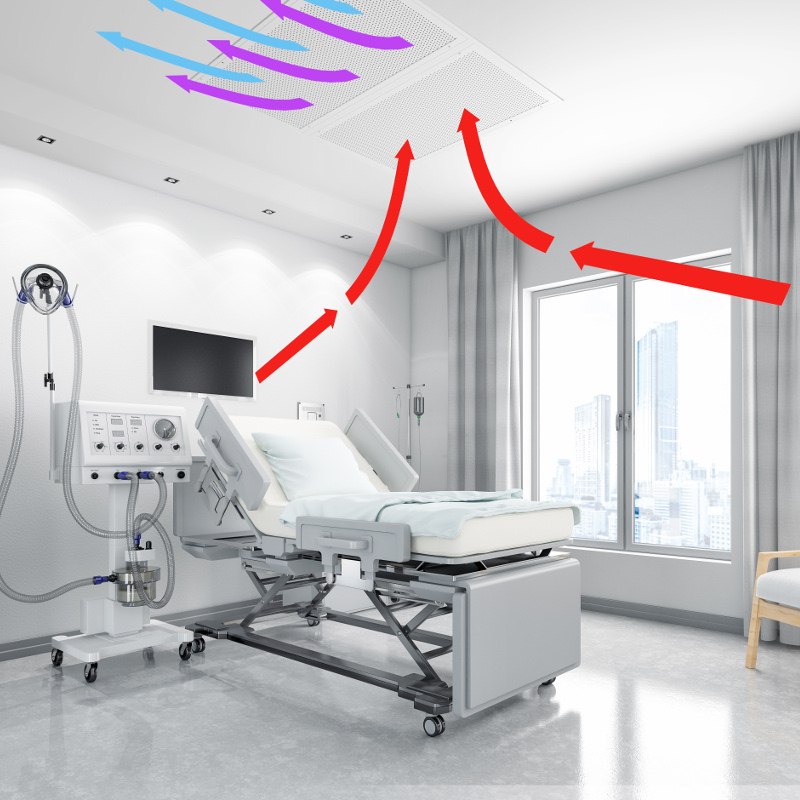Pandemic-Ready Patient Rooms for Healthcare from Price Industries

Eradicating the global pandemic brought on by COVID-19 has become a lengthier process than anticipated. Healthcare facilities are still struggling with the ebb and flow of demand for patient space.
How Do Negative Pressure Rooms Work?
Negative pressure rooms are used to isolate patients with contagious illnesses from other hospital patients, visitors, and staff. When the door is opened, the room’s air pressure is lower than the outside air pressure to prevent contaminated air from entering. The non-contaminated air is routed into the negative pressure room while the contaminated air is removed with special exhaust systems containing filters to clean the air before it is released outside the facility. As a result of the pandemic, these rooms have been in high demand; however, most hospitals usually only have a few of them because of the higher costs associated with building the rooms compared to not having any during non-pandemic times.
Price Industries, along with Antec Controls, offers a pandemic-ready patient room that can be used for either standard patient care or converted to a negative pressure room at the touch of a button. You can see the differences between a standard room and an isolation room in ASHRAE Standard 170-2017 for the Ventilation of Healthcare Facilities.
| Standard Patient Room | Negative Pressure Isolation Room | |
| Airflow: Fresh | 2 ACH | 2 ACH |
| Airflow: Total | 4 ACH | 12 ACH |
| Pressure Differential | No requirement | Negative 0.01 in. water gauge pressure monitor required |
| Exhaust | Washroom exhaust | Washroom exhaust. Room exhaust located near patient head and ducts directed outdoors |
| Return | Room return grille located near door | Return not allowed |
| Recirculation | Allowed | Only allowed if room air is recirculated locally through a HEPA filter |
| Supply Diffuser | Not specified | Air moves from clean to less-clean |
The airflow change per hour in the isolation room is significantly higher, as is the pressure differential requirement.
By relying on the Price Critical Area Recirculation/Exhaust System (CARES) in isolation mode, the pandemic ready patient room solution provides an adaptable and flexible solution that can be used after the COVID-19 outbreak.
How To Create Negative Air Pressure in an Isolation Room
While in isolation mode, the CARES combines an exhaust flow fan filter unit with a high-efficiency particulate air (HEPA) filter and a one-way, flush face radial flow diffuser to manage room airflow. The fan filter unit draws in contaminated room air and then passes it through a pre-filter and a HEPA filter to remove 99.99% of airborne contaminants, according to Price Industries. The radial flow diffuser distributes fresh air into the room along with a portion of the filtered air. The remainder of the filtered air is then exhausted out of the space to create a negative room pressure. An alarm from the pressure monitor will be triggered if the air pressure in the room is lost.
In the normal operation of the CARES unit, fresh supply air is distributed while room air is returned to the central air handler. In this normal operation, the return damper is open while the exhaust damper is closed, and the pressure monitor is on setback mode.
These multi-use rooms, complete with the HVAC system requirements demanded by ASHRAE for both standard patient care and isolation patient care offer many benefits to healthcare systems that are already strapped for space. Healthcare HVAC engineers would be wise to consider this option as an alternative to traditional isolation room designs.
For a video explanation of the system, please see the Price Industries video below.
// about the author
 Kelly Patterson
Kelly Patterson
Kelly Patterson is a lifelong learner and the marketing director at the Hoffman family of companies. There is nothing she likes more than talking about commercial HVAC systems and extraordinary customer service.












